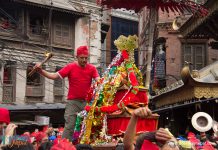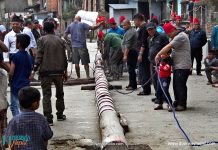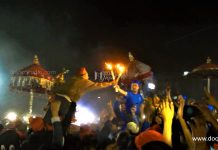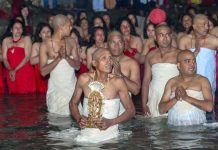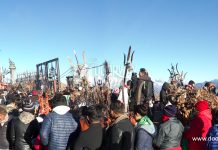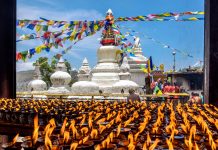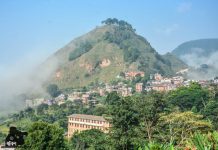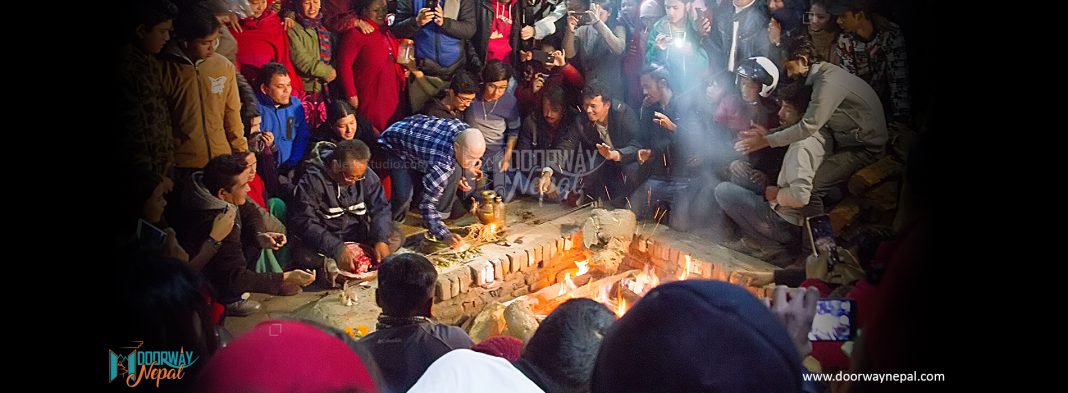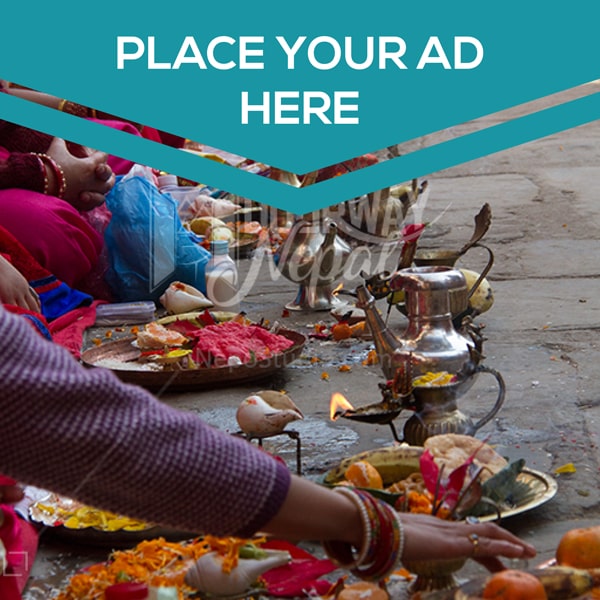Along with the preparation of Balachaturdashi, Indrayani Jatra (festival) too happens in parallel way. Goddess Indrayani, also known as Lunti Ajima, is one among eight Mother Goddesses of Astamatrika — Bhramayani, Rudrayani, Barahi, Kumari, Baishnavi, Chamunda and Maha Laxmi—in Shakta cult. Meanwhile, Kathmandu valley which in ancient days also known as Nepal and the dwellers here believe in Shakti or powerful Mother Goddesses and celebrates different festivities honoring these Mother Goddesses.
And Indrayani Jatra is one such festival where the close community of Newars’ living in Kathmandu Valley celebrates in much fanfare at Indrayani Temple situated near Bishnumati River. The festival begins in Margh Krishna Trayodasi and last for three days. Meanwhile on Margh Krishna Chaturdashi, Balachaturdshi, a festival dedicated to dead ancestor is celebrated in Pashupati area.
However, Balachaturdashi last for two days and Indrayani Jatra runs for three days from Margh Krishna Trayodasi till Ammabashya, this tends to fall on the month of December. There are three different interesting aspect of this festival. They are Sarpayagya Aahuti (rituals done in front of fire where living creatures such as fish, grasshopper, serpent, sparrow and head of water buffalo are offered in the fire), Khat Jatra (hand carried chariot procession of various local gods and goddesses circle around the core city) and Marajaa Nakegu (food given to children under eight years old). This festival is celebrated for welfare of children and country people.
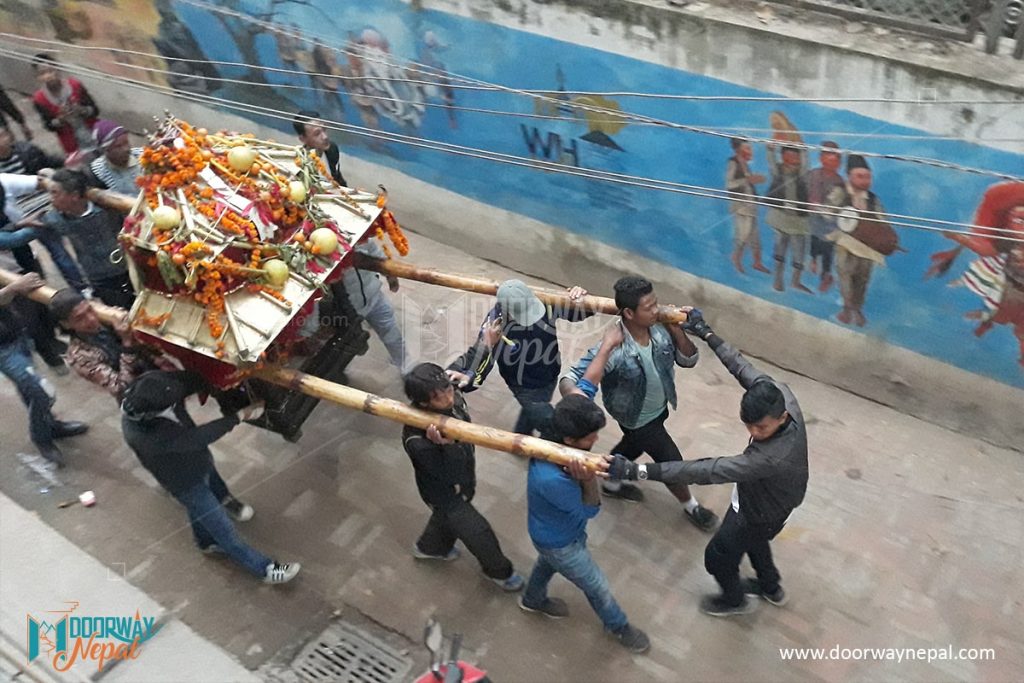
There are various legends about the beginning of this festival and according to one; there was seven sisters of Indrayani namely—Bhadrakali, Kankeshwori, Tankeshowri, Raktakali, Swetkali and Maitidevi. Among these seven sisters Indrayani was the one with many children and not so well off in comparison to her sisters. And once in a festival Indrayani and her children were invited for a feast, a day after the festival, while her sisters were invited on the festival day. They gave stale food to her and children, this broke Indrayani’s heart.
She left the house without food and as she was walking home children started to cry as they were starving. Upon reaching home she brought pumpkin from her neighbor’s house and as she was cooking it, the pumpkin turned into shiny gold. Afterwards she never had to live in poverty. And once she cooked meat of pig and let her children eat. Pig’s meat is considered impure and is not eaten by so called higher caste people in Newar people. Her act of letting her children eat this meat signifies valuing everyone as equal. Moreover, she announced that if people could celebrate a festival in her name and during the festival if the pig’s meat as prasad is given to the children she will bless those children and protect them from any harm. In Newari language Ajima literally means grandmother and Lunti means abundance with gold.
On the first day Sarpayagya Aahuti is performed. It is believed that the creatures that are going to put in fire should be caught from the premises of Indrayani Temple. Due to urbanization and more settlements around the surrounding creatures like grasshopper, snake and sparrow are not used these days. However, fish, head of water buffalo, lungs of water buffalo is offered to the fire for the Mother Goddess. And this offering is done only by Thaku Juju and only he can perform this ritual in the festival.
Throughout the following day people come in droves with trays of flowers and fruits to scatter over Indrayani. Raw eggs are broken over her idol by those who cannot afford a chicken, duck, lamb or goat. Many wait outside the small shrine over the beasts, and when the beast shakes his body and heads it is deemed acceptable to Indrayani. Later the headless body is carried three times around the fire before being taken home for family feasts, when it is consumed and regarded as a Prasad or blessing from the goddess.
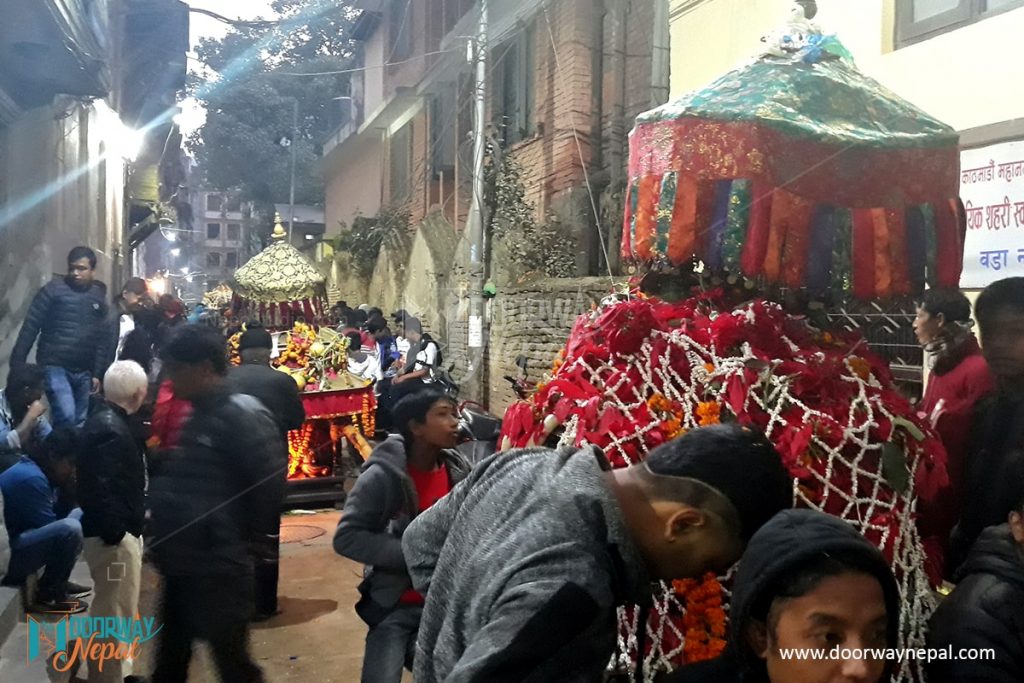
During this fourteenth night of the fortnight, decorated temple like palanquins containing patron goddesses of other Kathmandu localities are carried in procession to Indrayani’s temple. She herself is placed in a khat from which hangs a blood-red cloth painting of Indrayani holding a great bowl of blood. Shortly before daylight all the decorated palanquins are hoisted upon men’s shoulders and carried in gay, noisy parade to Tahiti Tole in Kathmandu—an open area where several streets meet at a Buddhist stupa shrine. In this procession of palanquins she is accompanied by her children namely Chhetrapati’s Shwanchapu Ganesh, Dhobichour’s Bhude Ganesh, Shova Bhagawati, Jwala Mai, and more joins, making the festivity more vibrant. With the puja by Thaku juju the gods and goddesses are taken to the homes of respective bhaktajan’s house.
Next day they are brought together and circle around the core city that begins from Jyatha, Talachi, Nyatwa, Kamalachhi, Bhotahitti, Mahabouddha, Tebahal, Dhrahara, Kchhichapokhari, Yangal, Lagan, Humat, Bhimsensthan, Maruhitti, Chasan, Bhurunkhel to Chhetrapati.
On the same day, children are given Marajaa as the Prasad from the Mother Goddess at the premises of Indrayani Temple and also mark the end of the festival.



